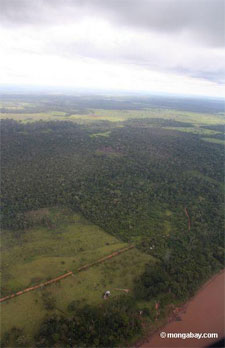Hudson Institute fellow calls Amazon savanna biome a wasteland
Editorial
Rhett A. Butler, mongabay.com
April 23, 2006
In an April 21st, 2006 editorial published in the Canada Free Press Dennis T. Avery, senior fellow for Hudson Institute in Washington, DC and the Director for Global Food Issues, called Brazil’s cerrado ecosystem a “wasteland” and criticized a recent report from the environmental activist group Greenpeace that linked Amazon deforestation to soy-based animal feed used by fast-food chains in Europe.
“Greenpeace should be thankful that Brazilian scientists have developed acid-tolerant soybean varieties that grow successfully on millions of acres of acid, brushy “cerrado” on Brazil’s central plateau,” Mr. Avery wrote. “Cerrado is not rain forest. It’s scrub land. Some of the cerrado is near the Amazon rain forest. Fortunately, those former wastelands are now helping provide better diets for millions of kids around the world because of high-tech plant breeding–instead of clearing huge tracts of the actual rainforest.”
Mr. Avery is correct in his assertion that converting cerrado, a prairie-like ecosystem, for agriculture is less damaging ecologically than the clearing of tropical rainforests, but few biologists would agree with his assertion that cerrado is wasteland. Scientists who have worked in the region say that the cerrado is the world’s most biologically rich savanna, home to more than 10,000 species of plants–4400 of which are endemic, 935 species of birds, and almost 300 mammals. Further, recent research indicates that the ecosystem provides important watershed services and plays an integral role in carbon cycling. However, due to agricultural conversion for soybean farms and cattle pasture, today the Brazilian cerrado is one of the most threatened eco-regions in South America.
 Rainforest Clearing in the Amazon Near Santarém, Brazil, some soy is grown on land reclaimed by forest after initial clearing some 50 years ago by subsistence farmers and cattle ranchers. |
While the vast majority of soybean production the Amazon occurs in the cerrado, the conversion of cerrado by large-scale industrial operators has increased pressures on Amazon forests by driving land speculators to clear neighboring forest while displacing smaller landholders who move into rainforest areas for subsistence agriculture. The improvement and construction of new roads has further fueled deforestation in the region.
In his haste to criticize Greenpeace report, Mr. Avery seemed to have skipped over some details in the document, appearing to be more intent on promoting his past work on the use of petroleum-based pesticides and fertilizers than focusing on the evidence actually presented by the environmental group. Specifically, Mr. Avery contends that soybeans described by Greenpeace “weren’t grown in the Amazon, they’re just being barged through to a seaport” neglecting the fact that the Greenpeace report tracked soy grown on farms in the Amazon rainforest biome, in and around the city of Santarém and the municipality of Belterra in the Brazilian state of Pará. While Mr. Avery is correct in that most Amazon soy is produced in the cerrado, he failed to disclose that some does come from the rainforest biome–especially in drier forest areas. In its report, Greenpeace lists several specific operations that grow soy in the Amazon rainforest.
Mr. Avery’s work on water issues and global hunger are admirable and commendable, but his recent editorial which fails to recognize the importance of the cerrado to the preservation of the rainforest does a disservice to his efforts.
Related articles
Greenpeace accuses McDonald’s of destroying the Amazon rainforest 04/07/2006
After a year-long investigation, environmental group Greenpeace has accused McDonald’s and other western firms of contributing to deforestation in the Amazon. Greenpeace’s report, published today, alleges that much of the soy-based animal feed used by fast-food chains to fatten chickens is derived from soybeans grown in the Amazon Basin of Brazil. Thanks to a new variety of soybean developed by Brazilian scientists to flourish in rainforest climate, soybean production has boomed in the region in recent years as firms have converted extensive areas of rainforest and cerrado, a savanna-like ecosystem, into industrial soybean farms. High soybean prices have also served as an impetus to expanding soybean cultivation and Brazil is on the verge of supplanting the United States as the world’s leading exporter of soybeans.
Brazil’s grasslands could replace food production of American heartland 08/01/2005
Today when Brazil is mentioned in the same sentence with “agriculture,” people often first envision the Amazon rainforest giving way to soybean plantations and cattle farms. While the Amazon is being converted for such purposes, the cerrado, a vast area of savanna-like grasslands covering more than 20% of the country’s surface area, is increasingly under threat as farmers from the United States and Europe are setting their sights on the biome’s sizeable agricultural potential.
Hudson Institute proposed damming Amazon river
In the 1960s the Hudson Institute of New York proposed building a massive earth dam across the mighty Amazon River at the Òbios narrows in Brazil. The dam would have created a massive reservoir and flooded a significant part of the Amazon basin. The hairbrained scheme was never taken seriously by the Brazilian government.